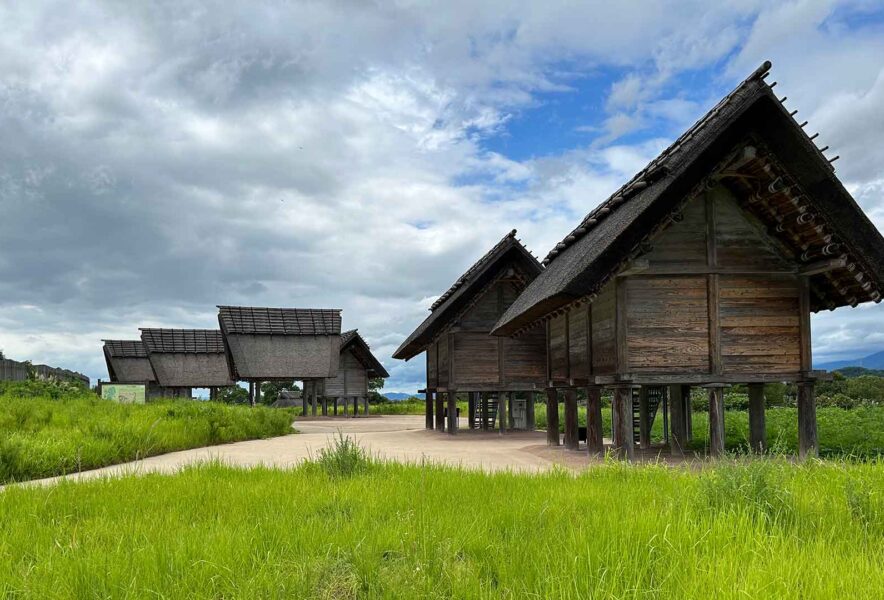Where did our ancestors come from and how did they spend their time?
One can recall such history and roots in the many ancient ruins that remain throughout the country.The traces of people’s daily lives and the tools they used to make their own products have been unearthed in the soil, evidence of their continuous existence in the area.However, not all of them have been preserved, and it is a fact that many more sites are demolished for building and construction once the survey is completed.
However, due to its academic value, a large area of the ruins has been preserved, and some of the buildings from that period have been restored and maintained as a historic site park. One such site is the Yoshinogari Ruins in Saga Prefecture. Let’s take a walk in Yoshinogari Historical Park today.
- What is Yoshinogari Ruins?
- The Yoshinogari Ruins are amazing here! Five recommended spots
- The “Ring Settlement Zone” So high! Reconstructed structures from the Yayoi Period
- The “Ring Settlement Zone” – Up close and personal observation of valuable excavated artifacts! Exhibition Room of Buried Cultural Properties
- Ancient Forest Zone” About 500 reconstructed graves of Yayoi people are here!
- Ancient Forest Zone” reproduces vegetation of the Yayoi period! Forest of Ancient Plants
- Visitors can also enjoy the “Ancient Hara Zone” activities!
- Summary: Was the Preservation of the Yoshinogari Ruins a Miracle? What was the drama leading up to the maintenance of the historic site?
- Yoshinogari Historical Park Access Information
- Enjoy the time and space of 700 years of the Yayoi period! Take a Stroll in Ancient Times at the Yoshinogeri RuinsーRecommended articles in the area
What is Yoshinogari Ruins?
The Yoshinogari Site is a Yayoi Period site located from present-day Kanzaki-shi, Saga Prefecture to Yoshinokaseri-cho, Kanzaki-gun, Saga Prefecture.
It is the largest site in Japan of a “moat encircling settlement,” in which the settlement was surrounded by a moat. The settlement survived for approximately 700 years from around the 5th century B.C. to the 3rd century A.D., all during the Yayoi period.
It is known that moat encircling settlements expanded from 2 hectares in the early Yayoi period to 20 hectares in the middle period and to over 40 hectares in the late period. This indicates the process by which the settlement grew from a village to the central region of the country throughout the Yayoi period.
The Yoshinogari Ruins were designated as a special national historic site in 1991 (Heisei 3), and as the second historical park in Japan, the Yoshinogari Ruins invite visitors to experience the romance of the Yayoi period.
Excavations that have been conducted since 1986 are still ongoing, and new discoveries are being reported one after another.

The Yoshinogari Ruins are amazing here! Five recommended spots
The Yoshinogari Ruins have been developed as the “Yoshinogari Historical Park,” a central national park, covering a total area of 117 hectares, including the surrounding environment. This vast area is about 25 times the size of the Tokyo Dome, and it may be difficult to see everything in a single day. Therefore, we would like to introduce some of the best spots in the Yoshinogeri Ruins. We recommend the East Entrance Gate to the ruins area!
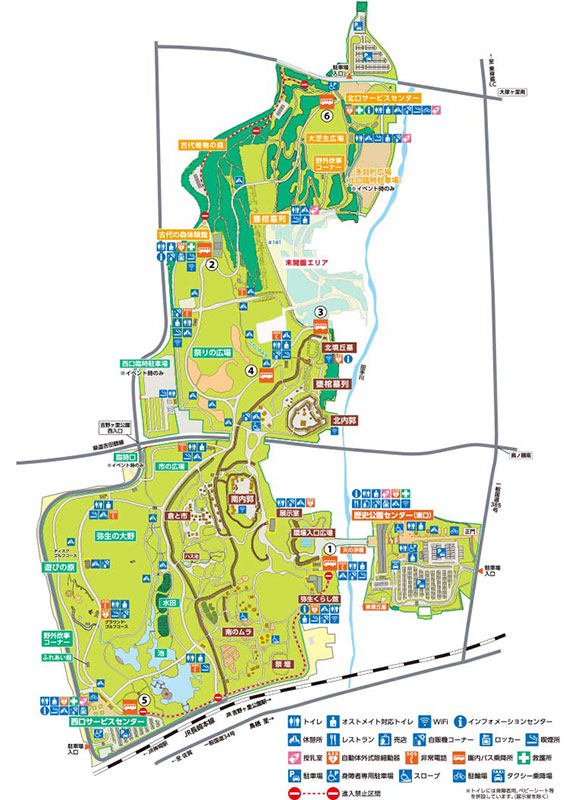
Map of the park:From the Official website
The “Ring Settlement Zone” So high! Reconstructed structures from the Yayoi Period
The best place to start is with the restored Yayoi Period structures. Located in the “Ring Settlement Zone,” these structures are a recreation of life in the late Yayoi period (around the 3rd century A.D.) and are a representative photogenic point of the Yoshinogari Ruins.


The three-story, 16.5-meter-high Main Festival Hall, one of the largest structures of the Yayoi period, is located in the area known as the “northern inner wall”. The interior is very spacious, with life-size dolls depicting the king and his retainers meeting on the first floor, and shrine maidens performing rituals on the second floor.



In addition, four 12-meter-high “watchtowers” and 20 buildings including pit houses have been reconstructed in the “southern inner wall”.

Many other structures, such as warehouses built on stilts, delight the eye, but the high-rise buildings of the Yayoi period are truly impressive. This is the period when the “Yoshinogari” known in the “Biographies of Wei and Wei” existed, and it can be felt that a great power, which can be called “Kuni”, developed in various areas.
The “Ring Settlement Zone” – Up close and personal observation of valuable excavated artifacts! Exhibition Room of Buried Cultural Properties
The “Buried Cultural Properties Exhibition Room” in the “Moat Encircling Settlement Zone” is also recommended to see the dynamic ruins of Yoshinogari and find out what kind of things were dug out of the ground.
This facility literally exhibits valuable artifacts excavated from the Yoshinogari Ruins, allowing visitors to observe up close the actual tools and vessels handmade and used by the people of that time.
The earthenware vessels large enough to hold one adult person, ornaments such as tuba-dama (a jade pipe) that were buried in the grave of a person of high rank, and stone knives used for harvesting rice, etc., allow visitors to feel the breath of the people of the Yayoi period.
One of the best parts of the exhibition is to enjoy looking at the exquisite craftsmanship of each item, or to think about how they were actually used, so to speak.
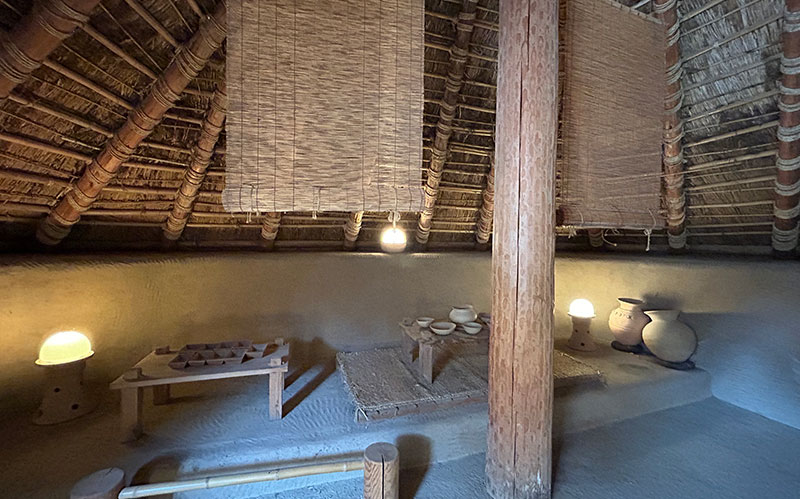
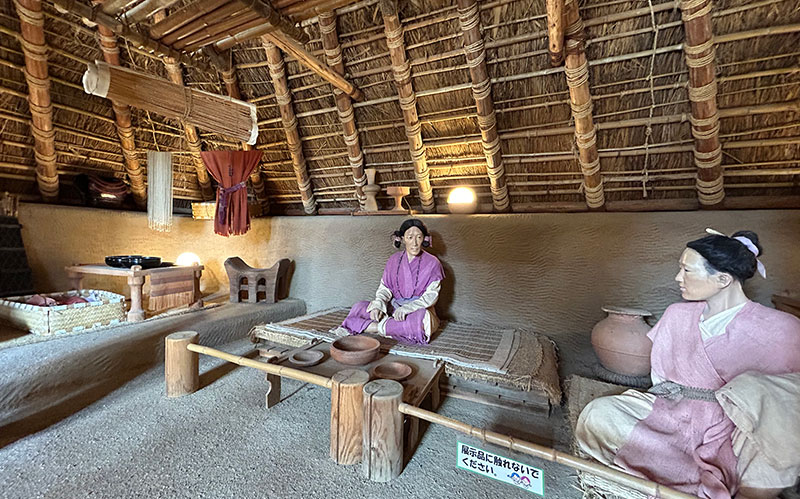
The stone knife, in particular, is easily mistaken for a tool for cutting due to the image of its name, but it is easier to imagine the harvest if you observe it with this and the fact that it is a type of “hoe-picking tool” for plucking rice ears between the fingers in mind.
It is also recommended to enter the museum when you are a little tired from your walk or want to avoid the sun and cold because of the indoor exhibits.
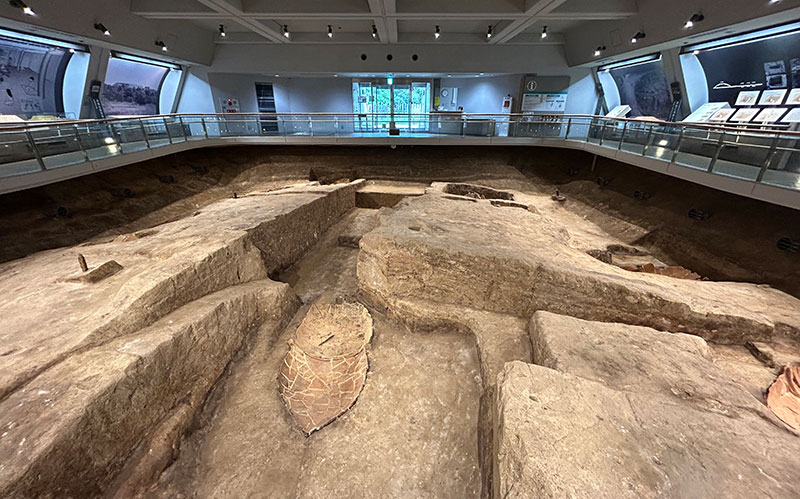
Ancient Forest Zone” About 500 reconstructed graves of Yayoi people are here!
In the “Ancient Forest Zone,” a magnificent row of tombs where people from the Yayoi period are buried has been reconstructed.
Here, tombs unique to the Yayoi period, called “kame-kanbo,” in which two large jars are combined to form a coffin, are particularly conspicuous. Approximately 3,000 jar coffin tombs have been excavated from the Yoshinogeri Site, of which about 1,000 were found in the Ancient Forest Zone, and about 500 have been reconstructed over a length of about 300 meters.
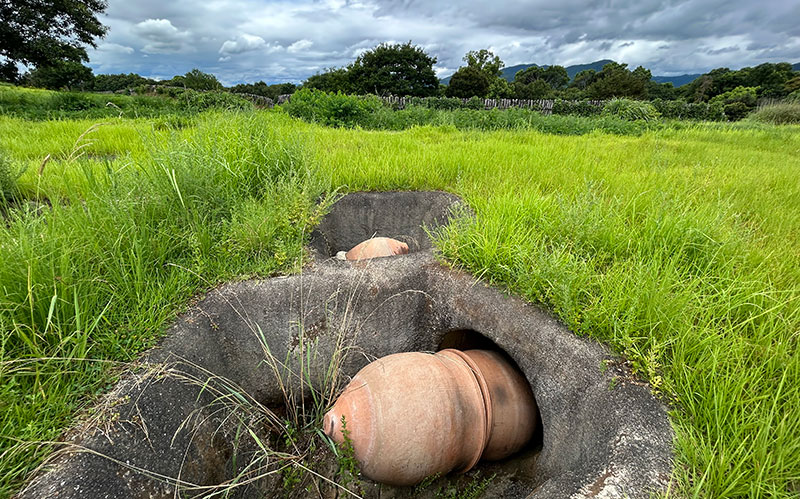
Because tombs are often very carefully constructed in many periods, and in some cases are accompanied by a variety of offerings that are well preserved, this is one of the sites that provides valuable clues to the history of the site.
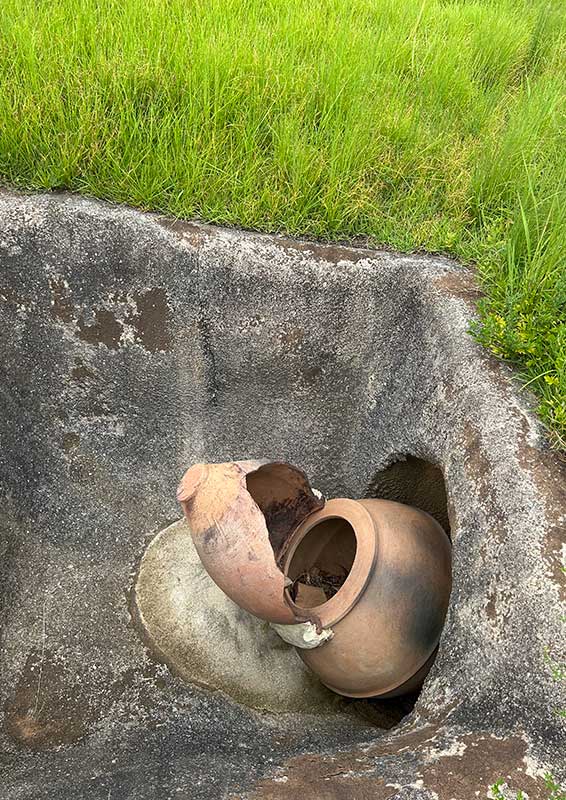
It can be felt that the feeling of mourning for loved ones is the same in all ages. The Yoshinokaseri Site shows one aspect of the Yayoi period as a necropolis (cemetery). Visitors can experience the life, beliefs, and social structure of ancient people and ponder the romance of prehistoric times.
Ancient Forest Zone” reproduces vegetation of the Yayoi period! Forest of Ancient Plants
Likewise, the “Ancient Forest Zone,” as the name suggests, recreates a forest that closely resembles the vegetation of the Yayoi period.
It is believed that trees with edible fruits such as oak, chestnut, shii, and oak were thriving in the area, and a “biological transplanting method” was used to transplant trees close to the vegetation of the time, together with soil containing various organisms as well as plants.
The Yayoi period is well known for the start of rice cultivation, which led to the eating of rice, but acorns and other hard fruits are also thought to have been a valuable food source during crop failures and food shortages.
The forests that provide such bounty are a lifeline, and a walk through them while thinking about ancient foods will give you a different view of the landscape.


Visitors can also enjoy the “Ancient Hara Zone” activities!
Yoshinogari Ruins is also a “park” and a place you can enjoy even if you are not a history buff.
The “Ancient Field Zone” includes the “Yayoi no Oono,” a 6-hectare open space where visitors can enjoy a variety of recreational activities. Here, visitors can enjoy sports such as ground golf and disc golf, and there are also areas for outdoor cooking such as barbecues.
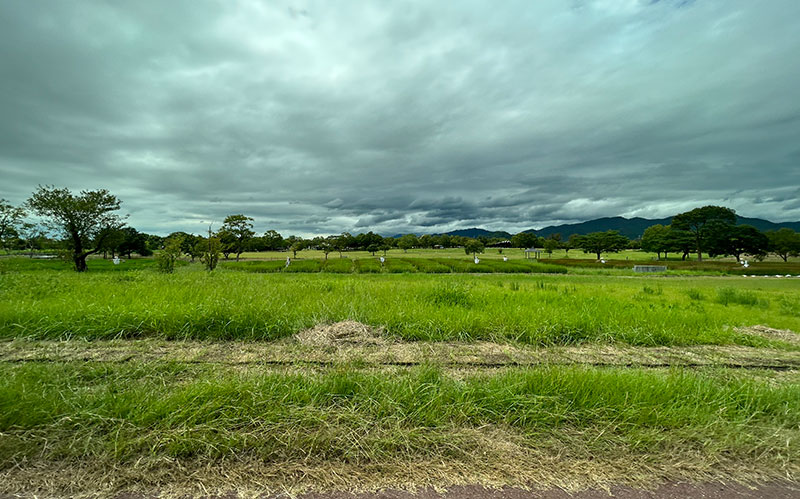
In addition, ancient rice paddies have been restored in the Ancient Hara Zone, where red rice, a type of ancient rice, is grown. The appeal of these places is to enjoy activities or take a walk at a leisurely pace while feeling the ancient atmosphere.
Although the Yoshinogeri Ruins are ruins of high academic value, they are not yet registered as a World Heritage site. However, more and more ancient ruins in Japan are being registered as World Heritage sites, and activities to promote the Yoshinogeri Ruins are ongoing. There is a possibility that in the future, it will become a place visited by people from all over the world.
Summary: Was the Preservation of the Yoshinogari Ruins a Miracle? What was the drama leading up to the maintenance of the historic site?
How was that?
The Yoshinogari Ruins are truly a time capsule, preserving 700 years of history from the Yayoi period. The fact that this great archaeological site remains today is the result of the efforts of people who were passionate about the preservation movement.
In fact, in 1982, it was decided that the Yoshinokaseri site would be developed as an industrial park. However, it was Tsugio Enaga, a native archaeologist and junior high school teacher at the time, who stressed the importance of the ruins. Tadashi Nanada, the discoverer of the ruins, had passed away the previous year, and Enaga followed his wishes and devoted himself to the preservation of the ruins.
After overcoming numerous difficulties, the movement spread and the preservation of the ruins was realized, which can be called miraculous. Please take a leisurely stroll around the Yoshinogari Ruins while thinking about this history.

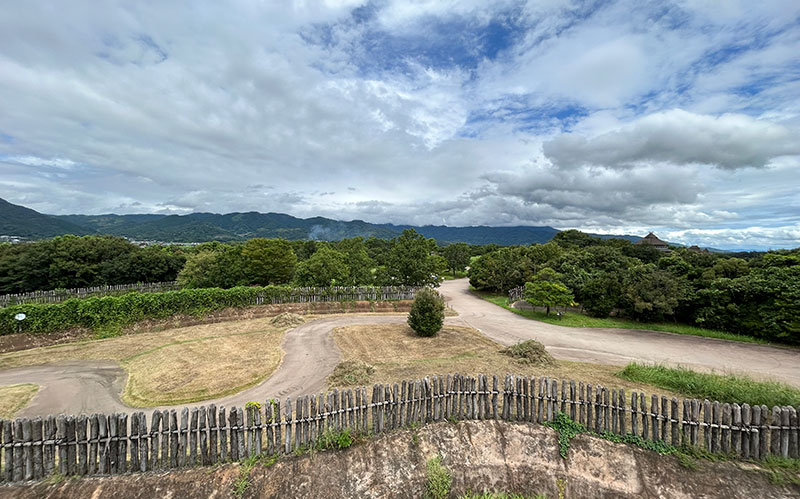
Yoshinogari Historical Park Access Information
Address: 1843 Tate, Yoshinogari-cho, Kanzaki-gun, Saga Prefecture
TEL:0952-55-9333
Opening hours: 9:00-17:00 (~18:00 from June 1 to August 31)
Closed: December 31, the third Monday of January and the following day
Fees: Adults (15 years and older): 460 yen / Junior high school students and younger: free / Silver (65 years and older): 200 yen
Train
Closest Station: Nagasaki Main Line
JRYoshinogari Koen Station(Approx. 15 min. walk to the park’s east entrance and main gate)、or JR Kanzaki Station(Approx. 15 min. walk to the park’s west exit and playground)
JR Hakata Station
↓Kagoshima Main Line, Nagasaki Main Line (Limited Express: approx. 20 min., Rapid: approx. 30 min.)
JR Tosu Station
↓Nagasaki Main Line Regular Train
JRYoshinogari Koen Station (about 14 minutes)、JRKanzaki Station(Approx. 17 minutes)
Bus
Highway bus
-Fukuoka Airport 11:20 Bus bound for Saga No. 2 Joint Government Office Building → 1,260 yen, approx. 52 min.
-Saga Station 12:00 departure for Fukuoka Airport International Bus → Yoshinogari Historical Park 530 yen, about 25 min.
Scheduled bus
Saga Station Nishitetsu Kurume or Shinai Gakuin Kurume bound bus → Tate, Yoshinogari Historical Park Minami 530 yen, about 40 min.
Nishitetsu Kurume Sta. bus bound for Saga No. 2 Joint Government Office → Tate, Yoshinogari Historical Park Minami 580 yen, approx. 40 min.
Vehicle
There are three parking lots: East Exit (540 spaces for standard cars), West Exit (310 spaces for standard cars), and North Exit (230 spaces for standard cars). The fee is 310 yen.
